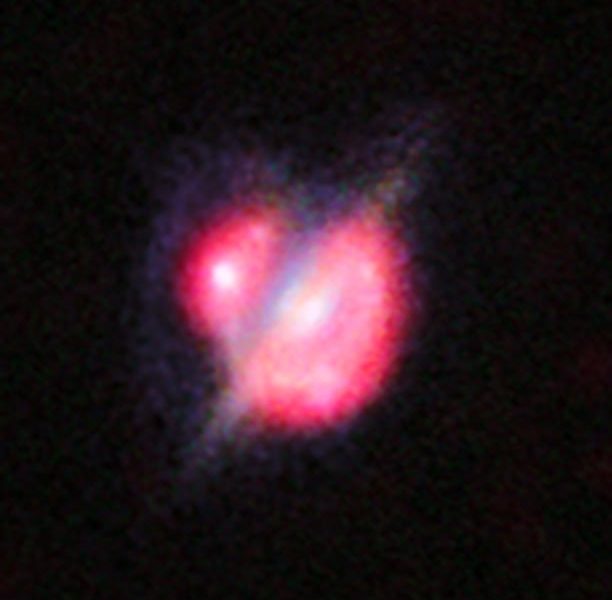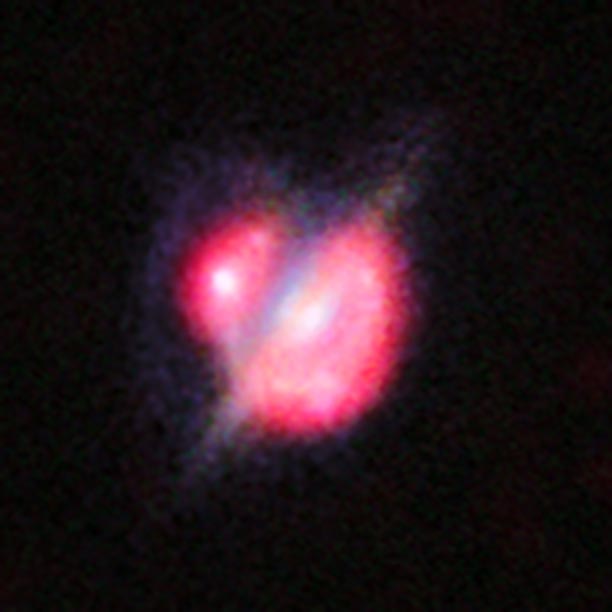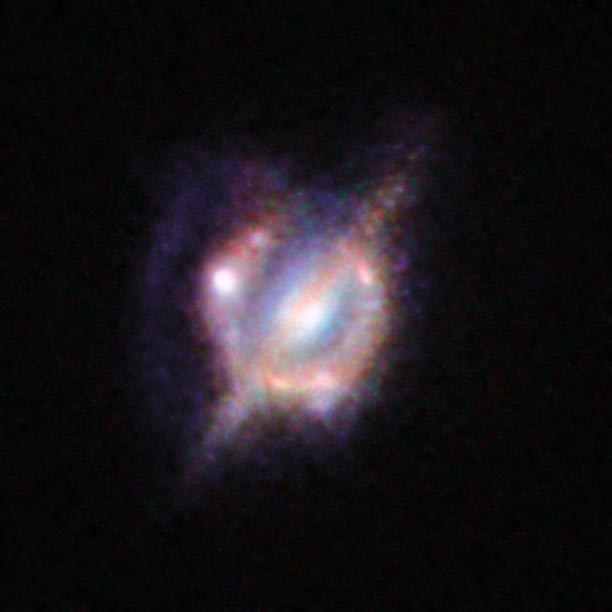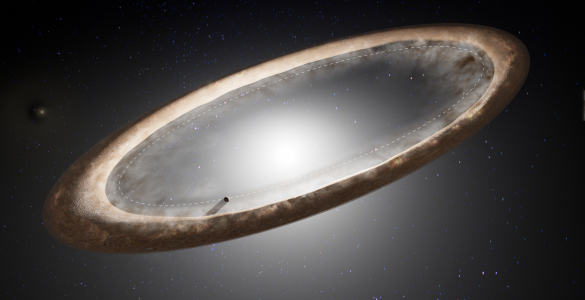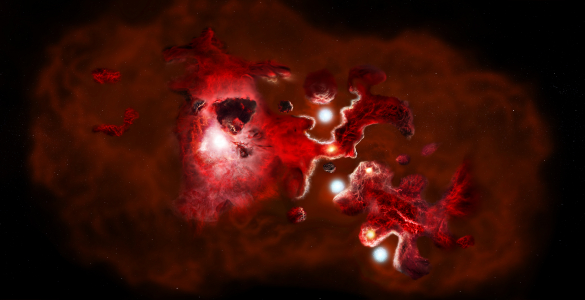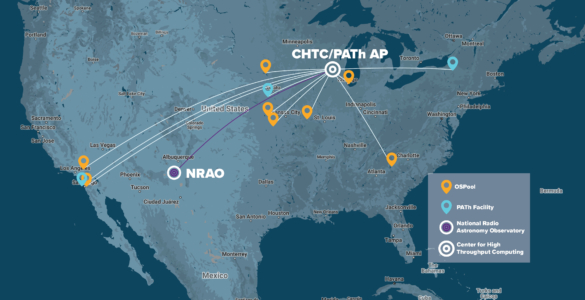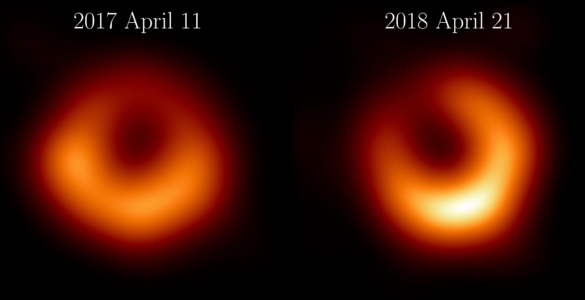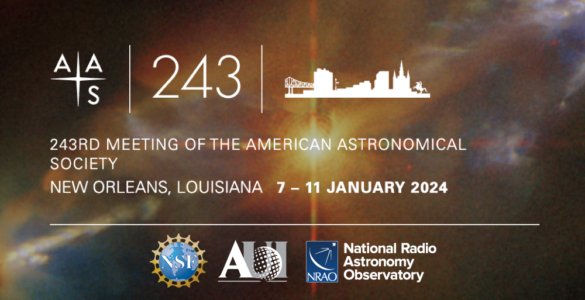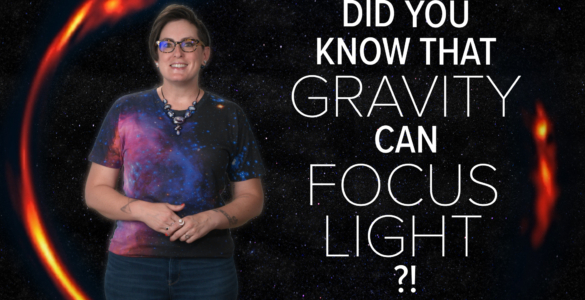ALMA, VLA, and other telescopes team-up with cosmic gravitational lens
An international team of astronomers using the Atacama Large Millimeter/submillimeter Array (ALMA) and the Karl G. Jansky Very Large Array (VLA) — among other telescopes — has obtained the best view yet of a collision between two galaxies when the Universe was only half its current age.
To make this observation, the team also enlisted the help of a gravitational lens, a galaxy-size magnifying glass, to reveal otherwise invisible detail. These new studies of galaxy HATLAS J142935.3-002836 have shown that this complex and distant object looks surprisingly like the comparatively nearby pair of colliding galaxies collectively known as the Antennae.
“While astronomers are often limited by the power of their telescopes, in some cases our ability to see detail is hugely boosted by natural lenses created by the Universe,” explains lead author Hugo Messias of the Universidad de Concepción in Chile and the Centro de Astronomia e Astrofísica da Universidade de Lisboa in Portugal. “Einstein predicted in his theory of General Relativity that, given enough mass, light does not travel in a straight line but will be bent in a similar way to a normal lens.”
Cosmic lenses are created by massive structures like galaxies and galaxy clusters, which bend light from objects behind them due to their strong gravity — an effect called gravitational lensing. The magnifying properties of this effect allow astronomers to study objects that would otherwise be invisible and to directly compare local galaxies with much more remote ones, when the Universe was significantly younger.
For these gravitational lenses to work, however, the foreground lensing galaxy and the one beyond need to be precisely aligned.
“These chance alignments are quite rare and tend to be hard to identify,” adds Messias, “but, recent studies have shown that by observing at far-infrared and millimeter wavelengths we can find these cases much more efficiently.”
HATLAS J142935.3-002836 (or H1429-0028 for short) is one of these sources and was found in the Herschel Astrophysical Terahertz Large Area Survey (HATLAS). It is among the brightest gravitationally lensed objects in the far-infrared regime found so far, even though we are seeing it at a time when the Universe was just half its current age.
To study this object in further detail, the astronomers started an extensive follow-up campaign using an impressive collection of incredibly powerful telescopes, including the Hubble Space Telescope, ALMA, the Keck Observatory, and the VLA, among others.
The Hubble and Keck images revealed a detailed gravitationally induced ring of light around the foreground galaxy. These high resolution images also showed that the lensing galaxy is an edge-on disc galaxy — similar to our Milky Way — which obscures parts of the background light due to the large dust clouds it contains.
But this obscuration is not a problem for ALMA and the VLA, since these two facilities observe the sky at longer wavelengths, which are unaffected by dust. Using the combined data, the team discovered that the background system was actually an ongoing collision between two galaxies. From this point on, ALMA and the VLA played a key role in further characterizing this object.
In particular, ALMA traced carbon monoxide, which allows detailed studies of star-formation mechanisms in galaxies. The ALMA observations also allowed the motion of the material in the galaxy to be measured. This was essential to show that the lensed object is indeed an ongoing galactic collision forming hundreds of new stars each year, and that one of the colliding galaxies still shows signs of rotation; an indication that it was a disc galaxy just before this encounter.
The system of these two colliding galaxies resembles a spectacular object that is much closer to us: the Antennae, which is the closest ongoing merger of two spiral galaxies. While the Antennae system is forming stars with a total rate of only a few ten times the mass of our Sun each year, H1429-0028 each year turns more than 400 solar masses of gas into new stars.
Shane Bussmann, co-author from Cornell University in Ithaca, N.Y., concludes: “The powerful synergy between the Herschel Space Observatory and our coordinated follow-up effort from ALMA, VLA, and other observatories around the world has dramatically improved our understanding of galaxy mergers when the Universe was half its present age.”
The National Radio Astronomy Observatory is a facility of the National Science Foundation, operated under cooperative agreement by Associated Universities, Inc.
More Information
The Atacama Large Millimeter/submillimeter Array (ALMA), an international astronomy facility, is a partnership of Europe, North America and East Asia in cooperation with the Republic of Chile. ALMA is funded in Europe by the European Southern Observatory (ESO), in North America by the U.S. National Science Foundation (NSF) in cooperation with the National Research Council of Canada (NRC) and the National Science Council of Taiwan (NSC) and in East Asia by the National Institutes of Natural Sciences (NINS) of Japan in cooperation with the Academia Sinica (AS) in Taiwan.
This research was presented in a the paper “Herschel-ATLAS and ALMA HATLAS J142935.3-002836, a lensed major merger at redshift 1.027”, by Hugo Messias et al., to appear online on 26 August 2014 in the journal Astronomy & Astrophysics.
The team is composed of Hugo Messias (Universidad de Concepción, Barrio Universitario, Chile, and Centro de Astronomia e Astrofísica da Universidade de Lisboa, Portugal), Simon Dye (School of Physics and Astronomy, University of Nottingham, UK), Neil Nagar (Universidad de Concepción, Barrio Universitario, Chile), Gustavo Orellana (Universidad de Concepción, Barrio Universitario, Chile), R. Shane Bussmann (Harvard-Smithsonian Center for Astrophysics, USA), Jae Calanog (Department of Physics & Astronomy, University of California, USA), Helmut Dannerbauer (Universität Wien, Institut für Astrophysik, Austria), Hai Fu (Astronomy Department, California Institute of Technology, USA), Edo Ibar (Pontificia Universidad Católica de Chile, Departamento de Astronomía y Astrofísica, Chile), Andrew Inohara (Department of Physics & Astronomy, University of California, USA), R. J. Ivison (Institute for Astronomy, University of Edinburgh, Royal Observatory, UK; ESO, Garching, Germany), Mattia Negrello (INAF, Osservatorio Astronomico di Padova, Italy), Dominik A. Riechers (Astronomy Department, California Institute of Technology, USA; Department of Astronomy, Cornell University, USA),Yun-Kyeong Sheen (Universidad de Concepción, Barrio Universitario, Chile), Simon Amber (The Open University, UK), Mark Birkinshaw (H H Wills Physics Laboratory, University of Bristol, UK; Harvard-Smithsonian Center for Astrophysics, USA), Nathan Bourne (School of Physics and Astronomy, University of Nottingham, UK), Dave L. Clements (Astrophysics Group, Imperial College London, UK), Asantha Cooray (Department of Physics & Astronomy, University of California, USA; Astronomy Department, California Institute of Technology, USA), Gianfranco De Zotti (INAF, Osservatorio Astronomico di Padova, Italy), Ricardo Demarco (Universidad de Concepción, Barrio Universitario, Chile), Loretta Dunne (Department of Physics and Astronomy, University of Canterbury, New Zealand; Institute for Astronomy, University of Edinburgh, Royal Observatory, UK), Stephen Eales (School of Physics and Astronomy, Cardiff University,UK) , Simone Fleuren (School of Mathematical Sciences, University of London, UK), Roxana E. Lupu (Department of Physics and Astronomy, University of Pennsylvania, USA), Steve J. Maddox (Department of Physics and Astronomy, University of Canterbury, New Zealand; Institute for Astronomy, University of Edinburgh, Royal Observatory, UK), Michal J. Michalowski (Institute for Astronomy, University of Edinburgh, Royal Observatory, UK), Alain Omont (Institut d’Astrophysique de Paris, UPMC Univ. Paris, France), Kate Rowlands (School of Physics & Astronomy, University of St Andrews, UK), Dan Smith (Centre for Astrophysics Research, Science & Technology Research Institute, University of Hertfordshire, UK), Matt Smith (School of Physics and Astronomy, Cardiff University, UK) and Elisabetta Valiante (School of Physics and Astronomy, Cardiff University, UK)
Contacts:
Charles E. Blue, Public Information Officer
National Radio Astronomy Observatory
+1 (434) 296-0314; Email: cblue@nrao.edu
Hugo Messias
Universidad de Concepción, Chile
Centro de Astronomia e Astrofísica da Universidade de Lisboa, Portugal
Email: hmessias@oal.ul.pt






